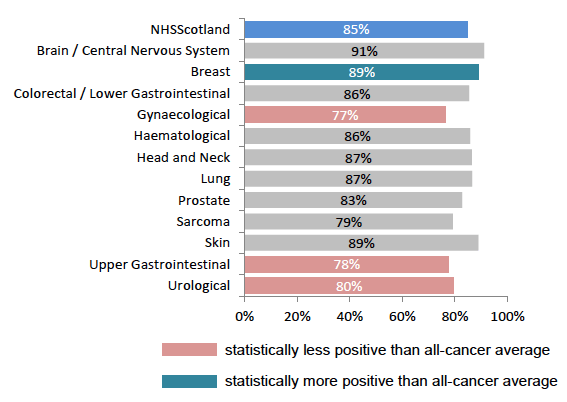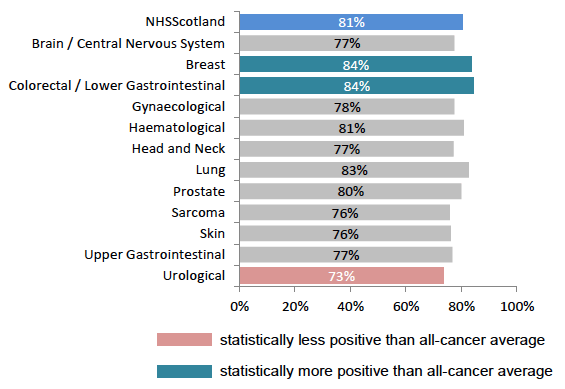Scottish Cancer Patient Experience Survey 2015/16
Results from the 2015/16 Scottish Cancer Patient Experience Survey. The survey covers the full care journey that a cancer patient experiences, from thinking that something might be wrong with them to the support they received after their acute-care treatm
This document is part of a collection
Diagnostic tests
In this section we ask patients who have undergone a diagnostic test such as an endoscopy, biopsy, mammogram or scan their views on the process.
This can involve taking in a large amount of information - often both complicated and with a personal impact - and can be an unsettling time for patients.
Therefore it's important we find out whether patients had enough written information about their tests, whether the results of the tests were explained clearly, and how they felt about the length of time they had to wait to have the tests.
The vast majority of respondents (96%) reported having some form of diagnostic test for their cancer (Figure 4).
Figure 4: Has patient had diagnostic test

Information about the test
Of the patients that did have a diagnostic test, the large majority (92%) had the information they needed beforehand. Amongst those that did not have the information they needed, there was more or less an equal desire for more verbal and more written information (Table 5).
Table 5: Information before diagnostic test
| Beforehand, did you have all the information you needed about your test? |
n |
% |
|---|---|---|
| Yes |
3,941 |
92% |
| No, I would have liked more written information |
145 |
3% |
| No, I would have liked more verbal information |
158 |
4% |
| No, I would have liked BOTH more written information and more verbal information |
50 |
1% |
| Total |
4,294 |
100% |
Patients from different tumour groups responded differently regarding having enough information about their diagnostic tests. Patients with colorectal / lower gastrointestinal tumours were statistically more likely to respond positively (96%), whereas patients with gynaecological (86%) and skin tumours (85%) were statistically less positive (Figure 5).
Figure 5: % given written information before test, by tumour group

Time waiting for diagnostic test to be done
The majority of patients (85%) felt that the length of time waiting for their diagnostic test to be done was 'about right' (Table 6).
Table 6: Length of time waiting for diagnostic test to be done
| Overall, how did you feel about the length of time you had to wait for your test to be done? |
n |
% |
|---|---|---|
| It was about right |
3,812 |
85% |
| It was a little too long |
493 |
11% |
| It was much too long |
188 |
4% |
| Total |
4,493 |
100% |
There was some variation in how patients from different tumour groups responded to the question. Breast cancer patients were statistically more likely than the all-tumour average to respond that their wait was 'about right' (89%). Upper gastrointestinal (78%), gynaecological (77%) and urological (80%) tumour groups were all statistically below the average (Figure 6).
Figure 6: % positive about test wait, by tumour group

Understanding the test results.
Most patients (81%) felt that the tests were explained to them in a way they could understand 'completely'. Around one in six (18%) only understood their test results 'to some extent'. A very small percentage either received no explanation or did not understand the explanation given (Table 7).
Table 7: Explanation of test results
| Were the results of the test explained in a way you could understand? |
n |
% |
|---|---|---|
| Yes, completely |
3,637 |
81% |
| Yes, to some extent |
805 |
18% |
| No, I did not understand the explanation |
36 |
1% |
| I did not have an explanation but would have liked one |
40 |
1% |
| Total |
4,518 |
100% |
Patients with breast and colorectal / lower gastrointestinal tumours were statistically more positive about the way that their results had been explained than the all-cancer average (both saw 84% of patients responding 'yes, completely'). Urological tumour patients were less positive (73% responding 'yes, completely') (Figure 7).
Figure 7: % receiving understandable explanation of test results, by tumour group

Contact
There is a problem
Thanks for your feedback